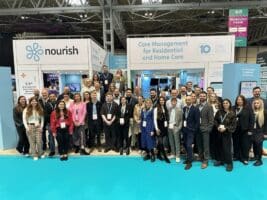It takes a lot of hard work to make something look easy. It takes hard work and coproduction to make something easy to use. At Nourish Care we pride ourselves on the intuitive structure and accessibility of our products. We put an incredible amount of time and effort into the useability of our platforms. From concept and discovery, to prototypes, iterations and testing. At every step of the way we remain engaged with our users to ensure that our users can engage with our software. Creating a continuous cycle of feedback for us and consistently evolving solutions for our users. We are currently building a new iteration of our Better Care at Home mobile app. A process deeply rooted in and shaped by the experiences of our current Better Care at Home users.
The stage of discovery
Every new product and feature at Nourish begins the same way. With a process of discovery. Over the years at Nourish our approach to discovery has changed and expanded. However, the focus remains on gathering as much information from as many perspectives as possible. This routinely involves sending a survey out to all of the relevant Nourish users. For example, the Nourish Better Care at Home survey was focussed on home care providers and their communities.
We then take the responses to this survey and bring them to a multi-disciplinary team (MDT) at Nourish. This team consists of engineers, designers and researchers. They work together, guided by the survey responses and other user insights, and build a prototype. From there we move to our initial stage of testing.
An internal test for useability
The first test we conduct on this prototype is done internally. The first steps of anything are generally best done in private after all. At Nourish, we have always been informed by the rich, first hand, care experience that exists throughout our company. We ask Nourish employees with relative experience, but who aren’t on the design team, to test the prototype.
These tests are both moderated and unmoderated. What that means is some tests are conducted in office. While others are done privately, at home and out in the community. We trust the experience of our team members to apply the prototype honestly and earnestly. We then conduct follow up interviews to review their experience and apply that into the next stage of development.
This initial group of testers tends to be fairly small, generally between five and ten people. Our MDT for the project then iterate based on the feedback they received. This process is led by our user experience designer. Throughout this iterative process the team routinely checks in with customer facing Nourish employees for their perspective. This includes primarily our Account Managers and Customer Support Managers. The people who most routinely interact with Nourish users and best understand your day-to-day needs. Their feedback is fed into the iterative process alongside the results of our internal testing. This ensures we keep both our users and the people they support in mind while designing and sets us up with a final prototype. Once we have this ‘final prototype’ it’s time for, you guessed it, more testing!
Testing the final prototype’s useability
The key to good design is to keep the right parties engaged throughout the process. At Nourish this means consistently involving the people using our system in the design process. For the final round of testing we return to the initial one, discovery. When conducting surveys, we include an option to sign up for the usability test of the product. These sign-ups unlock an unmoderated and quantitative research base for us to utilise. Which provides a crucial contrast to our initial testing. Where once we used a small, internal team, now we want to cast as wide a net externally as possible.
Think of it like this, a user experience designer walks into a bar. They order a beer, they order 10 beers, they order –1 beers, they order 1000 beers. Everything works fine, they leave happily. A customer walks into a bar and asks where the bathroom is. The bar explodes.
No internal test will ever predict everything an external user base will try with a platform. Furthermore, no internal team could ever truly predict everything a user will need. In technology generally, and in social care explicitly, there is little room for error. By testing our prototype with a wide range of users we get a much more informed picture of what it’s application will look like.
We can review engagement to learn patterns of behaviour. Highlighting which aspects of the platform get the most use or take the longest time to complete. Crucially, it also gives us a better insight into the sentiment of the users. Not just how well did it work, but how did using the platform make you feel? All of this information is invaluable for promoting useability and a testament to the power of coproduction in care technology.
Making Better Care at Home better
This process has revealed several points of attention and necessary tweaks in Better Care at Home. We more clearly understood the impact and benefit of our emergency admission pack button thanks to the wealth of positive feedback received for it.
It also shows us some areas of difficulty or navigation blind spots we previously missed in the workflow. Points like a clickable button not appearing clickable leading to user confusion. Or people feeling like a particular function should be accomplishable in one click rather than multiple clicks through several pages.
We improve useability in our products by mapping our workflows to the mental model of our users. Repeating this process and valuing the feedback of our users sincerely is what enables us to move from iteration to intuition.
The final result
With Nourish Better Care at Home, ultimately, what we are hoping to achieve is pretty straightforward. We want to make the new mobile app easy to use on an ongoing basis. A platform that is intuitive and adaptive, so carers can spend more time well informed and with the people they support. Delivering quality care is always going to be rewarding, but hard work, the least we can do is make the technology easy. Of course, we couldn’t do it without you.
Learn more about our new app for Better Care at Home, and how we’re building the future of care technology with our users.








